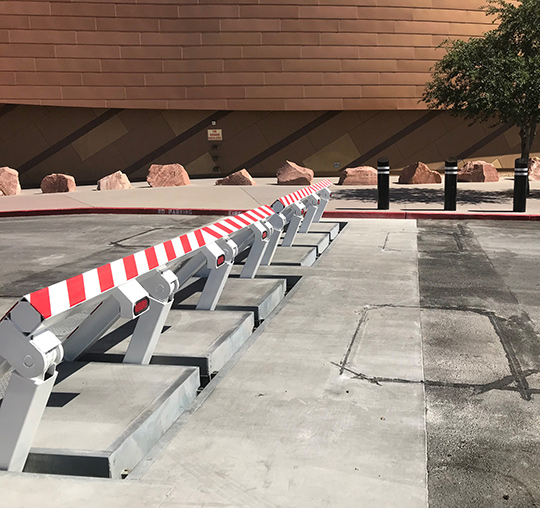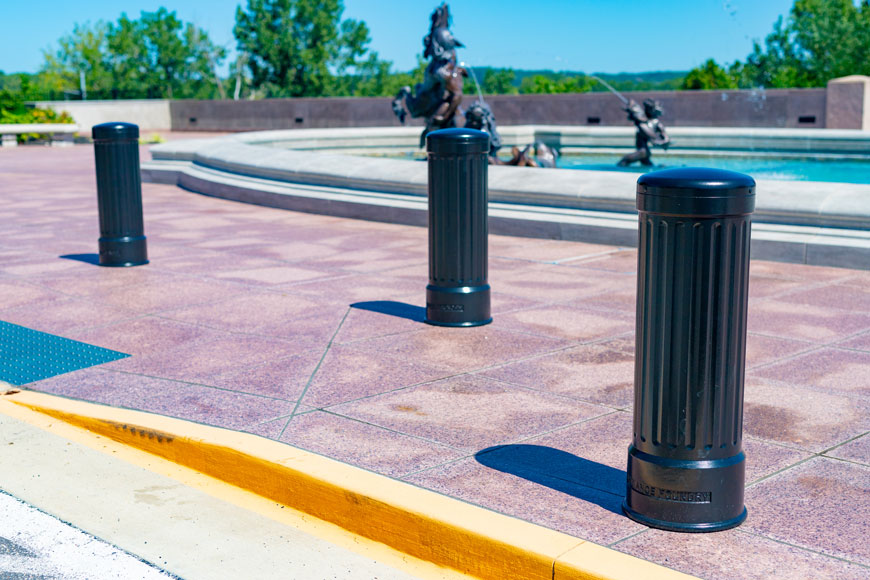The Ultimate Guide To Wedge Barriers
The Facts About Wedge Barriers Uncovered
Table of ContentsThe smart Trick of Wedge Barriers That Nobody is DiscussingWhat Does Wedge Barriers Do?

Wedge Barriers Fundamentals Explained
The remaining pressure applied to
the cam webcam deploy the wedge plate 16 may be provided given an electromechanical actuator 84 or other various other. The spring assembly 54 and the actuator 84(e. Wedge Barriers. g., electromechanical actuator)might run together to translate the web cam and lift the wedge plate 16.
As pointed out over, the springtime setting up 54 applies a consistent pressure on the webcam, while the electromechanical actuator may be managed to exert a variable pressure on the webcam, thereby enabling the lifting and decreasing( i. e., releasing and withdrawing )of the wedge plate 16. In specific embodiments, the constant pressure applied by the spring setting up 54 may be flexible. g., electromechanical actuator) is handicapped. As will be valued, the springtime assembly 54 might be covered and protected from particles or various other aspects by a cover plate(e. g., cover plate 68 displayed in FIG. 4) that might be significantly flush with the elevated surface area 38 of the foundation 14. As pointed out above, in the released position, the wedge plate 16 serves to obstruct access or travel past the obstacle 10. The obstacle 10(e. g., the wedge plate 16 )may obstruct pedestrians or vehicles from accessing a home or pathway. As talked about above, the obstacle 10 is connected to the support 30 protected within the foundation 14,

front brackets 71. Consequently, the affiliation settings up 72 may pivot and rotate to enable the collapse and extension of the linkage settings up 72 during retraction and deployment of the bather 10. The linkage settings up 72 reason motion of the wedge plate 16 to be limited. If an automobile is traveling in the direction of the deployed wedge plate 16(e. For instance, in one scenario, the safety legs 86 might be extended throughoutmaintenance of the barrier 10. When the safety and security legs 86 are released, the safety legs 86 sustain the weight of the wedge plate 16 go to this website against the surface 12. Therefore, the lifting system 50 might be shut down, serviced, removed, changed, and so forth. FIG. 5 is partial perspective sight of a personification of the surface-mounted wedge-style barrier 10, showing the webcam 80 and the cam surface areas 82 of the lifting mechanism 50. Specifically, two webcam surfaces 82, which are referred to as reduced webcam surfaces 83, are positioned listed below the cam 80. The reduced web cam surfaces 83 may be fixed to the surface area 12 (e. For example, the lower camera surfaces 83 and the installing plate 85 might create a single item that is protected to the support 30 by screws or other mechanical bolts. In addition, 2 web cam surface areas 82, which are described as upper webcam surfaces 87, are placed over the webcam 80 and combined to (e. In other embodiments, stepping in layers or plates might be placed in between the surface 12 and the reduced webcam surfaces 83 Our site and/or the wedge plate 16 and the top camera surface areas 87 As discussed above, the cam
80 translates along the webcam surface areas 82 when the wedge plate 16 is lifted from the withdrawed setting to the deployed position. Furthermore, as mentioned over, the spring setting up 54 (see FIG. 3 )might offer a force acting upon the web cam 80 in the instructions 102 using springtime rod 58, which might lower the pressure the electromechanical actuator 84 is required to use to the cam 80 in order to activate and raise the wedge plate 16. 1 )to the released position(see FIG. 4). As revealed, the web cam 80 consists of track wheels 104(e. g., rollers), which call and equate along the camera surfaces 82 throughout procedure.